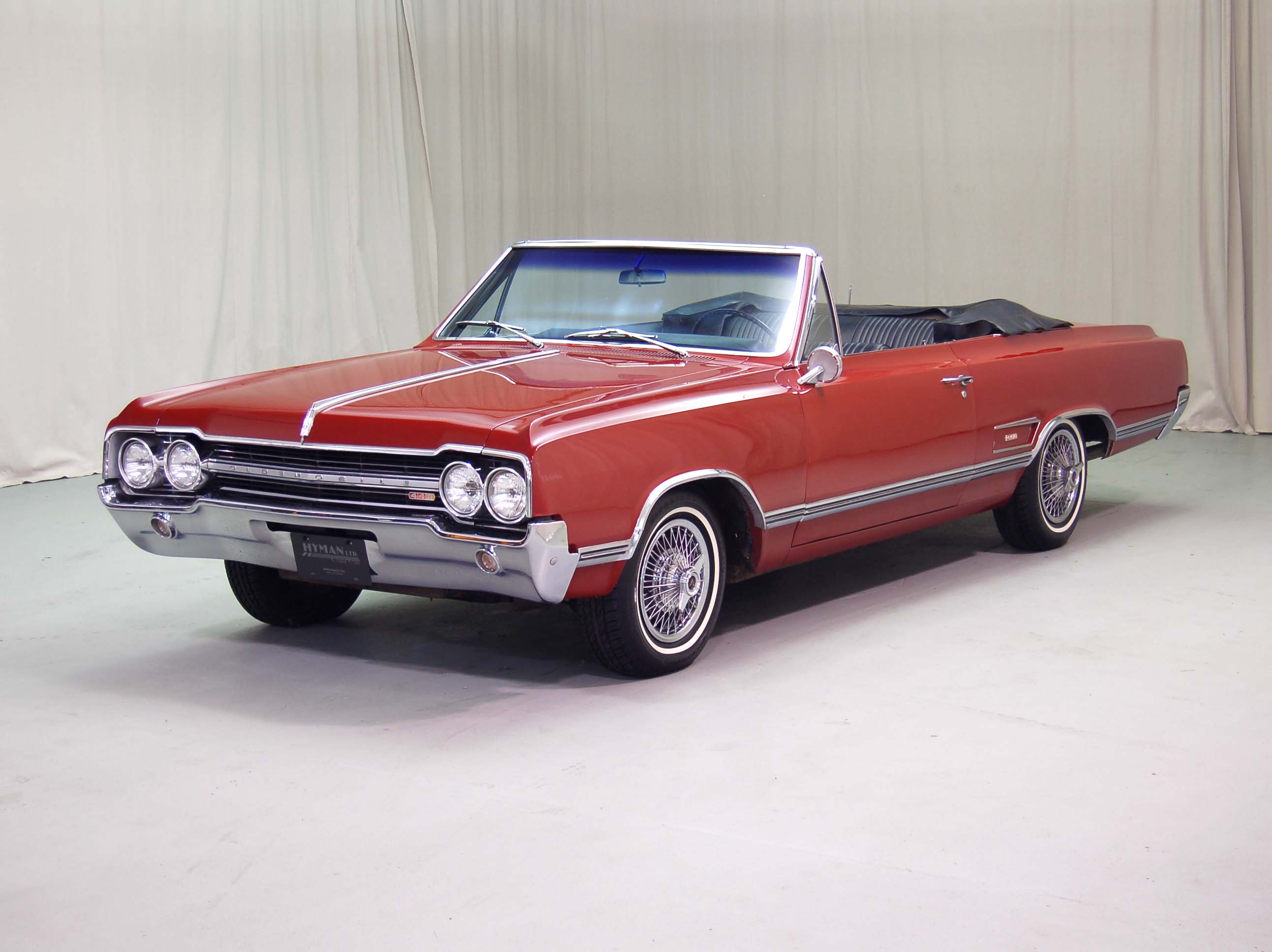Oldsmobile 4-4-2: Happy 50th to a ‘Police Car’
Whatever you do, don’t call it the “four-forty-two.” It’s the “four-four-two.”
It’s the 50th anniversary of the introduction of Oldsmobile’s muscle car, the 4-4-2. Sad to say, we’re also marking the 10th anniversary of the Oldsmobile Division’s demise. That’s too bad, because General Motors’ current portfolio of powertrains and rear-drive platforms could have yielded a genuine, 400-plus horsepower 4-4-2. Oh well.
Pontiac had pulled a fast one to get the 1964 GTO into production, hiding its 389 cubic-inch V-8 inside an option package to skirt General Motors’ 10-pounds-per-cubic-inch limit rule. That is, a 3,400-pound Tempest should not have had anything larger than the Pontiac 326-cube V-8.
Oldsmobile had previously tried to boost performance in its F-85 compact, offering the turbocharged Jetfire coupe in 1962 and 1963. The results were problematic, to put it kindly. But even when the 1964 GTO’s instant success and profitability swiftly put an end to the “10 pounds” rule, Oldsmobile followed a cautious path to build its first muscle model.
Late in the 1964 model year, Olds cooked up the 4-4-2 package, also known as the “Police Apprehender Pursuit” package, which turned its compact into a credible muscle coupe or sedan. The 4-4-2 upgrade cost $285 on an F-85 and $136 on the upscale Cutlass.
The small 4-4-2 badges denoted the package’s 4-barrel carburetor, 4-speed manual transmission and dual exhaust. It must have been confusing to see a magazine ad for the 4-4-2 that showed two uniformed policemen in a sedan, though Olds did make a few 4-4-2 sedans that one season.
Oldsmobile built the 4-4-2 around its new 330 cubic-inch V-8, a low-deck version of its second-generation V-8. A high-deck version would yield the 400- and 425 cubic-inch versions the following year. The 330, which offered 290 horses in the Cutlass, was tweaked with a hotter cam and dual-snorkel air cleaner to yield 310 hp and 355 lb.-ft. of torque. While just 15 hp off the base GTO’s engine, the 330 was substantially down from the Poncho’s 428 lb.-ft. torque peak. And Olds had nothing to counter the GTO’s TriPower three-carb option.
The rest of the 4-4-2 package, however, reflected Oldsmobile’s focus on all-around performance. Olds gave the F-85 chassis a good going-over, using a stiffer frame and the police suspension package. In addition to stiffer springs and shock absorbers and wider redline tires, the package added a thicker front anti-roll bar and included a novelty at the time — a rear anti-roll bar.
Also something of a novelty, the only transmission you could get in the 1964 4-4-2 was the heavy-duty 4-speed. That would change in subsequent years, to meet market demand.
The first 4-4-2 was perhaps too low-key for the buyers the GTO was attracting. Olds gave the 4-4-2 redline tires but had yet to discover the youth appeal of hood scoops, chrome exhaust splitters and styled wheels. All of those would come in later seasons.
Motor Trend ran an Olds 4-4-2 from 0-to-60 in 7.5 seconds and the quarter-mile in 15.5 at 90 mph. The performance was just a bit off the pace of a standard GTO, but the Olds showed better handling prowess. The lack of a GTO-like image, along with the lack of tire-burning torque and lack of marketing, held 4-4-2 sales to just 2,999 for 1964 — 1/10 of GTO sales.
Olds learned the ropes quickly, and the 1965 4-4-2 package got the new 400 V-8 with 345 horses and 440 lb.-ft. of torque, plus the option of a two-speed automatic. The meaning of 4-4-2 became somewhat flexible; for 1965, it indicated a 400 cubic-inch engine, 4-barrel carb and dual exhausts.
Performance options, muscle car design cues and youth-baiting advertising escalated with each season. Among the highlights: the three-carb option for 1966-1967; the W-30 package with Forced Air induction and other performance upgrades; becoming a separate model for 1968; and getting the 455 engine in 1970 (after it had been used in the Hurst/Olds for two years).
Sales of the 4-4-2 peaked in 1968 at about 33,000 — a pretty good showing against 63,000 SS-396 Chevelles, 87,600 GTOs and 84,000 Plymouth Road Runners.
The Olds 4-4-2 left an indelible mark in the muscle car segment, even if Olds tarnished it somewhat by turning it into a trim package in the 1970s. A Hurst/Olds revival model in the early ’80s gave way to a new 4-4-2 for 1985-1987, with a 4-speed automatic transmission, 4-barrel carburetor and, of course, dual exhausts for its Olds 307 cube V-8. About 11,500 were made over three years.
The final car to carry the 4-4-2 badge, a front-drive Olds Calais with a 4-cylinder, 4-valve, 2-cam Quad-4 engine, offered a quick ride but lacked the old muscle car magic.


